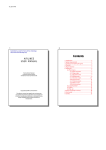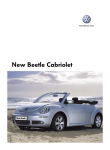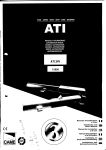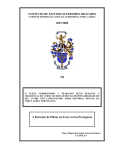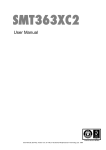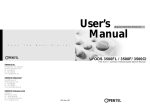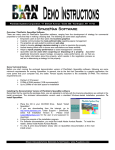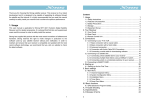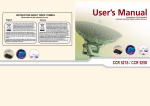Download User Guide (PDF Version, 151.51 kb )
Transcript
USER GUIDE CHARTER ON-FLIGHT ORIGIN AND DESTINATION REPORT STATEMENT 2 (I,II,III,IV,V,F) is to be completed for : a) domestic and international charter transportation services using fixed wing aircraft having a take-off weight greater than 15 900 kgs (35,000 lbs). b) transborder charter transportation services, between Canada and the United States, using fixed wing aircraft having a maximum take-off weight greater than 8 200 kgs (18,000 lbs). CONTACT: Kathie Davidson Survey Manager, Air Charter Statistics (613) 951-0141 (T) (613) 951-0010 (F) [email protected] June 2000 Ce guide est aussi disponible en français. TABLE OF CONTENTS I General Description of Survey..................................................................................................3 II Authority and Participation ........................................................................................................3 III Confidentiality............................................................................................................................3 IV Federal Data Sharing Agreement.............................................................................................4 V Submission of Reports..............................................................................................................4 VI Detailed Instructions for Reporting on Statement 2(I,II,III,IV,V,F) a) Definition and Explanation of Concepts .......................................................................5 -Itinerary ........................................................................................................................5 -On Flight Origin and Destination.................................................................................5 -Simple Charter Flight and Circle Charter Flight..........................................................6 b) Explanation of Each Field on Statement 2(I,II,III,IV,V,F) .............................................8 c) Reporting Flight Data and Examples .........................................................................10 VII Editing of Recorded Data........................................................................................................20 VIII Glossary ..................................................................................................................................20 APPENDIX A: Valid Aircraft Type Codes ..............................................................................24 APPENDIX B: Metric Conversion Table ................................................................................29 APPENDIX C: Carrier Pre-Edit Checks Recommended for Statement 2(I,II,III,IV,V,F) .......30 APPENDIX D: Diskette Record Layout..................................................................................31 2 I GENERAL DESCRIPTION OF SURVEY The Charter On-flight Origin and Destination Survey collects information on passengers and goods carried on various types of charter flights. Participating carriers report complete origin and destination data for domestic, Canada-United States and international charter services. These data are to be reported on an ongoing monthly basis by both Canadian and foreign air carriers. The data that carriers provide will be used to monitor the air industry, regulate international air services, ensure safety, plan and maintain the air transportation system and provide industry inputs into the System of National Accounts. II AUTHORITY AND PARTICIPATION The Charter On-flight Origin and Destination Report Statement 2 (I,II,III,IV,V,F) is required under: 1- the Statistics Act, Revised Status of Canada 1985, Chapter S19; 2- Section 50 of the Canada Transportation Act, the Carriers Information Regulations; 3- Paragraph 86(1) (i) of the Canada Transportation Act, ‘Regulations Amending the Air Transportation Regulations’. Canadian air carriers that perform non-entity domestic charter services as well as Canadian and foreign air carriers that perform international charter commercial air services, using aircraft which have a maximum authorized take-off weight greater than 15 900 kilograms (35,000 lbs), are required to file Statement 2 (I,II,III,IV,V,F) with the Aviation Statistics Centre. Air carriers that perform transborder charter commercial air services between Canada and the United States, using aircraft which have a maximum authorized take-off weight greater than 8 200 kilograms (18,000 lbs), are also required to file Statement 2 (I,II,III,IV,V,F) with the Aviation Statistics Centre. III CONFIDENTIALITY The data reported on Statement 2 (I,II,III,IV,V,F) questionnaires will be treated in confidence. The questionnaires will be edited by personnel sworn under the Statistics Act and access will be restricted to authorized personnel. Where carrier specific data are published, existing or equivalent data series will be maintained and there will be no increase in level of detail over what has been published in the past without prior consultation with the carriers involved. The confidentiality provisions of the Statistics Act are not affected by either the Access to Information Act or any other legislation. 3 IV FEDERAL DATA SHARING AGREEMENT To avoid duplicating survey activity and therefore, to reduce response burden and minimize collection and processing costs, Statistics Canada has entered, under Section 12 of the Statistics Act, into data sharing agreements with both Transport Canada and the Canadian Transportation Agency. First, the information provided on this statement is collected by Statistics Canada persuant to the Statistics Act. The information provided on this statement covering federally-regulated carriers is also collected on behalf of Transport Canada pursuant to Canada Transportation Act and the Carriers, Transportation and Grain Handling Undertakings Information Regulations. Lastly, the information provided on this statement is also collected on behalf of the Canadian Transportation Agency pursuant to the Canada Transportation Act and the Air Transportation Regulations. Under these data sharing agreements, information provided on this statement are kept confidential and used for statistical purposes only. V SUBMISSION OF REPORTS Reports are to be filed on a monthly basis with the Aviation Statistics Centre, and are due within thirty (30) days of the last day of the reporting month. Blank Statement 2(I,II,III,IV,V,F) forms and return envelopes will be sent to participating carriers. Additional statements and envelopes are available upon request from the Aviation Statistics Centre by telephoning (613) 951-0161 or by writing to the following address : Aviation Statistics Centre OTTAWA, Ontario, Canada. K1A 0T6 4 VI DETAILED INSTRUCTIONS FOR REPORTING ON STATEMENT 2 (I,II,III,IV,V,F) All fields on the questionnaire must be completed. To indicate a nil value, please enter a zero "0". If an item is not applicable, enter a dash "-". a) Definition and Explanation of Concepts Itinerary For the purpose of this survey, itinerary means the routing of the aircraft starting at the first point where the aircraft is loaded 1 and ending at the final point where the aircraft is completely unloaded. On Flight Origin and Destination The major purpose of this survey is to identify where the passengers and/or cargo come from and where they are going; that is, to define the load's origin and destination as opposed to the flight's or aircraft's origin and destination. The on-flight origin and destination concept is simple when the itinerary consists of only two airports, A and B, with the aircraft departing from A and destined for B. In this case, the airport of enplanement, A, is the origin and the airport of deplanement, B, is the destination. However, when the itinerary is made up of more than two airports, the on-flight origin and destination concept may not be so obvious. The general rule is: for each airport of enplanement, the enplaned traffic that is subsequently deplaned at each downline airport must be reported. The airports are to be reported in the same order as they occur in the itinerary. Thus, each airport of enplanement is an origin and each airport of deplanement is a destination. Consider the following itinerary: → A B → C the aircraft departs from A, goes to B, then C. If A is an airport of enplanement, look for (in the order B,C) the subsequent downline airports in the itinerary for which the enplaned load is destined. The two possible destinations are B and C. The load enplaned at A may be destined entirely for B, or entirely for C, or a part of the load for B and the other part for C. The origin will be A and the destinations B and C for this enplaned load. The second point in the itinerary is B. If B is also an airport of enplanement, look for the subsequent downline airports in the itinerary for which the enplaned load is destined. In this case, the only possible destination is C. The origin will be B and the destination C for the load enplaned at B. 1 a load being a number of passengers and/or a quantity of cargo. 5 Simple Charter Flight and Circle Charter Flight A simple charter flight is a flight for which the first point of the itinerary is different from the last point of the itinerary. Only one flight number is assigned to a simple charter flight. TWO SIMPLE FLIGHTS (round trip) Initial point of the itinerary A A ↓ ↑ Final point of the itinerary Flight # 510 B B Flight # 511 Final point of the itinerary ↓ ↑ C C Initial point of the itinerary Itinerary: (outbound) A → B → flight # 510 C Itinerary: (inbound) C → B → flight # 511 A 2 itineraries, 2 flight numbers 6 A circle charter flight is a return flight which follows a circular itinerary. A circular itinerary begins and ends at the same point. The inbound portion does not retrace the path of the outbound portion. In other words, except for the initial point (which is also the final point) each point is visited only once. The final point in the itinerary is the point where the aircraft is completely unloaded. Two flight numbers are assigned to a circle charter flight. CIRCLE FLIGHT (round trip) Final point of the itinerary A Ê Flight # 511 Initial point of the itinerary Ì Å C Flight # 510 B Flight # 510 Itinerary: (round trip) Flight # 511 A Æ B Æ C Æ A Flight # 510 1 itinerary, 2 flight numbers To conclude, a return flight which has three or more airports must either be one circle flight or two simple flights. 7 b) Explanation of Each Field on Statement 2 (I,II,III,IV,V,F) Field Page Number - Each page shall be numbered in sequence in the space provided. For example, page 1 of 35. Carrier - The full name of the air carrier filing the form shall be written on the top right-hand corner of the form, in the space provided. 07 Carrier code - The carrier code to be used is the one in the most recent issue of the Official Airline Guide. Those air carriers that do not appear in the Official Airline Guide should leave this field empty. 11 Year and month - These cells are to be completed with numbers to identify the year and the month to which the report relates. For example, June 2000 would be shown as: 200006 17 Unit of Weight Used - Check the appropriate box to indicate whether Statement 2 (I,II,III,IV,V,F) will be completed using metric or imperial weights. Metric units are preferable. 18 Flight Number - The flight number should be the exact number which was used in communication with the airport tower or radio operator. 22 Circle Flight - Indicate with an asterisk ("*") the point where the turnaround occurs in a circle flight. (i.e., where the flight number changes). 23 Aircraft Type - Report the alpha/numeric designator used in the Air Traffic Control (A.T.C.) flight plan. (Do not use a dash). The valid codes are listed in Appendix A. 28 Available Seats - Please report the total number of seats in the aircraft available for occupancy by revenue passengers. 32 Number of Tonnes/ Tons Available for Revenue Goods - Report, as accurately as possible, the number of metric tonnes (1 000 kgs) or imperial tons (2,000 lbs) of capacity available for revenue goods. A conversion table has been included in Appendix B to assist you. 38 46 Enplanement/Deplanement Airport OAG - Please use three-letter codes as shown in the Official Airline Guide. For airports without a code, please write the full name of the airport. If there is more than one airport in a city, specify which airport was used. 42 50 Departure/Arrival Date - Report the date using the local time of departure and not the scheduled departure/arrival time. Enter the date as four digits: month first, then day. January 15th, for example, would be reported as 01 15. Please ensure that all flights for a given month are reported on the Statement 2(I,II,III,IV,V,F) filed for that month. The month in which a flight is reported will be determined when the flight left the point of origin. That is, a 01/ 04 8 flight departing on January 31st, which arrives at all or some destinations on February 1st, will be reported, in its entirety, on Statement 2(I,II,III,IV,V,F) for January. 54 Charter Type - The charter type is to be coded as follows: Domestic Charter Flights: DC Transborder Charter Flights: TP, TN, TG, TC International Charter Flights: AB, AT, CP, EC, EN, IT Definitions of these charter types are found in the glossary. Note: Transborder courier goods are to be coded in a separate category from other transborder goods, under the charter type TC. Subcontracts An air carrier operating a charter service on behalf of another air carrier is responsible for ensuring that the required charter data are filed. 56 Number of Canadian Origin Passengers - The number of revenue passengers who began a one way or round trip in Canada. The passenger counts must be broken down by city-pair and charter type. Passengers on domestic charters are always of Canadian origin. 61 Number of Foreign Origin Passengers - The number of revenue passengers who began a one way or a round trip in a country other than Canada. For example, if a passenger enplaned in Canada travelling to Europe on the return portion of a round trip, the passenger would be considered to have a foreign origin. The passenger count must be broken down by city-pair and charter type. In the case of domestic charters, this field is to contain a dash "-". 65 Goods - This includes both entity and bellyhold cargo. Please report the weight to one decimal place in either metric tonnes (1 000 kgs) or imperial tons (2,000 lbs). Report bellyhold cargo on the same line as that of the passenger charter flight on which the cargo was carried. 69 End of Flight - Indicate the end of each flight by putting a "1" in this column. This will eliminate any confusion caused by a multiple leg journey. Authorized Officer and Telephone Number The authorized officer who reports the data on Statement 2 (I,II,III,IV,V,F) should print his/her name and phone number including the area code and, where applicable, the extension number in the space provided at the bottom of the form. c) Reporting Flight Data and Examples 9 Again, this survey is concerned with the passenger's or cargo's origin and destination, not the flight's or aircraft's origin and destination. A city-pair A-B, as part of a flight, must be reported if passengers/cargo are enplaned at A and destined for B. Do not report a city-pair C-D if passengers/cargo enplaned at C are not destined for D. Also, ferry flights need not be reported. Detailed instructions for reporting different types of charter flights are provided on the following pages. The city-pair examples use passengers and reflect the most common type of flights; however, the same method of reporting can be applied to entity cargo or courier cargo. i) Examples of Simple Charter Flights Example 1. A flight with one origin and one destination. Flight # 510 Itinerary: Æ A origin B destination The aircraft transports passengers enplaned at A for the point B. The city-pair to be reported is: Flight number 510 City-Pair AÆB Passengers •number of passengers enplaned at A and destined for B. In the case of a flight with one origin and destination, the number of passengers enplaned at A is equal to the number of passengers deplaned at B. The aircraft is loaded at A and completely unloaded at B. Note that Canadian origin and foreign origin passengers must be reported separately but on the same line. A numeric example is explained on the following page. 10 Example 1: Charter flight: one origin and one destination (passengers only) - Itinerary: Flight Number: YYZ → 510 TPA / TPA YYZ - Type of aircraft: B747 Available seats: 430 → YYZ 315 passengers enplane at YYZ: TPA → → 285 Canadian origin 30 foreign origin 285 deplane at TPA 30 deplane at TPA → TPA 400 passengers enplane at TPA: Note: → 511 300 Canadian origin 100 foreign origin YYZ → → 300 deplane at YYZ 100 deplane at YYZ If this flight also contained bellyhold, its weight amount would be inserted in the Revenue Goods column (field #65) on the same line as the passengers reported on this flight. 11 Example 2. A flight with one origin and two destinations. Flight # 4235 Itinerary: origin A Æ B Æ destinations C The aircraft transports passengers enplaned at A for the points B and C. The aircraft is completely unloaded at the last point in the itinerary (point C). The city-pairs to be reported are: Flight Number City-Pair Passengers 4235 A ÆB -number of passengers enplaned at A destined for B. 4235 A ÆC -number of passengers enplaned at A destined for C. Special case In most of these flights, the passengers enplaned at A are destined for B or C. However, if some passengers are enplaned at B destined for C, the city-pair B-C must be reported since there are passengers for which the origin is B and the destination is C. In this special case, the city-pairs to be reported are: Flight Number City-Pair Passengers 4235 4235 4235 A ÆB A ÆC B ÆC -number of passengers enplaned at A destined for B. -number of passengers enplaned at A destined for C. -number of passengers enplaned at B destined for C. The city-pairs have to be reported in the order shown in the examples. A numeric example is explained on the following page. 12 Example 2: Charter flight: one origin and two destinations (passengers only) - Itinerary: Flight number: YYZ 4235 YYZ 190 passengers enplane at YYZ: → PAR → LON → 160 Canadian origin 30 foreign origin → PAR → 80 deplane at PAR → → Type of aircraft: B757 Available seats: 220 LON 80 deplane at LON 30 deplane at LON 13 Example 3. A flight with two origins and one destination. Flight # 4234 Itinerary: A origins Æ B Æ C destination the aircraft departs from A, goes to B and then C. The aircraft transports passengers enplaned at A and B for the point C. The aircraft is completely unloaded at the last point in the itinerary (point C). The city-pairs to be reported are: Flight Number 4234 4234 City-Pair Passengers A ÆC B ÆC -number of passengers enplaned at A destined for C. -number of passengers enplaned at B destined for C. Special case In most of these flights, the passengers enplaned at A or B are destined for C. However, if some passengers are enplaned at A destined for B, the city-pair A-B must be reported since there are passengers for which the origin is A and the destination is B. In this special case, the city-pair to be reported are: Flight Number 4234 4234 4234 City-Pair Passengers A ÆB A ÆC B ÆC -number of passengers enplaned at A destined for B. -number of passengers enplaned at A destined for C. -number of passengers enplaned at B destined for C. A numeric example is explained on the following page. 14 Example 3: Charter flight: two origins and one destination (passengers only) - Itinerary: Flight number: ORY 4234 ORY 80 passengers enplane at ORY: → LGW → →YYZ - LGW 40 Canadian origin 40 foreign origin 100 enplane at LGW: Type of aircraft: B757 Available seats: 220 → → → 60 Canadian origin → 40 foreign origin → YYZ 40 deplane at YYZ 40 deplane at YYZ 60 deplane at YYZ 40 deplane at YYZ Note: The same rules will apply in a cargo only situation. 15 Example 4. A flight with two origins and two destinations. flight # 425 Itinerary: A origins Æ B Æ C Æ destinations D the aircraft departs from A, goes to B, then C, and then D. The aircraft transports passengers enplaned at A or B to the two (out of Canada) points C or D. The aircraft is completely unloaded at the last point in the itinerary (point D). The city-pairs to be reported are: Flight Number 425 425 425 425 City-Pair Passengers A A B B ÆC ÆD ÆC ÆD -number of passengers enplaned at A destined for C. -number of passengers enplaned at A destined for D. -number of passengers enplaned at B destined for C. -number of passengers enplaned at B destined for D. Special case In most of these flights, the passengers enplaned at A or B are destined for C or D. However, if some passengers are enplaned at A destined for B or enplaned at C destined for D, the city-pairs A-B or C-D must be reported since there are passengers for which the origin and destination are A and B or C and D. In this special case, the city-pairs to be reported are: Flight Number 425 425 425 425 425 425 City-Pair Passengers A A A B B C Æ Æ Æ Æ Æ Æ B C D C D D -number of passengers enplaned at A destined for B. -number of passengers enplaned at A destined for C. -number of passengers enplaned at A destined for D. -number of passengers enplaned at B destined for C. -number of passengers enplaned at B destined for D. -number of passengers enplaned at C destined for D. A numeric example is explained on the following page. 16 Example 4: Charter flight: two origins and two destinations (passengers only) - Itinerary: Flight number: LAS 80 passengers enplane at LAS: LAS 425 → PHX → YYC → → PHX 10 Canadian origin 70 foreign origin → → 50 passengers enplane at PHX: YEG → 5 Canadian origin 45 foreign origin → - Type of aircraft: B737 Available seats: 140 YYC → 10 deplane at YYC 50 deplane at YYC → 20 deplane at YEG 25 deplane at YYC → → 5 deplane at YEG 20 deplane at YEG YEG 17 ii) Example of a Circle Charter Flight Only one example of a circle flight is explained in this part. It is the case involving three airports. (Circle flights must have a minimum of three points). This type of circle flight is the simplest and also the most common for charter flights. Specific instructions for circle flights involving more than three airports are available by contacting the Aviation Statistics Centre. Example 1. A circle flight with three points. Flight # 421 Itinerary: A Æ Flight # 422 Æ B C Æ A the aircraft departs from A, goes to B, goes to C, then goes back to A. The aircraft transports passengers enplaned at A to the points B or C. Also, the aircraft transports passengers enplaned at B or C to the point A. The city-pairs to be reported are: Flight Number City-Pair 421 421 421/422 422 A A B C Note: Æ Æ Æ Æ B C A A Passengers -number of passengers enplaned at A destined for B. -number of passengers enplaned at A destined for C. -number of passengers enplaned at B destined for A. -number of passengers enplaned at C destined for A. When a city-pair involves two different flight numbers (as B-A in the example, i.e. the passengers going from B to A travel on flight 421 from B to C, stay on board at C, and travel on flight 422 from C to A), then both flight numbers must be reported in the space provided for flight number. Also, you will have to place an asterisk in the field 22, to indicate the point where the turnaround occurs in a circle flight. 18 Example 1: Circle flight: three points (passengers only) - YUL Itinerary: Flight number: → 421 YUL → 421 et 422 → 220 passengers enplane at YMX: 180 Canadian origin 40 foreign origin TPA TPA → → MIA → → 80 deplane at TPA → 20 deplane at TPA 421 YUL - → MIA → → 100 deplane at MIA 20 deplane at MIA → Type of aircraft: B757 Available seats: 220 → 422 100 passengers enplane at TPA: 75 Canadian origin 25 foreign origin 200 passengers enplane at MIA: 175 Canadian origin 25 foreign origin YUL → → 75 deplane at YUL 25 deplane at YUL → → 175 deplane at YUL 25 deplane at YUL 19 VII EDITING OF RECORDED DATA Each air carrier is to develop its own editing procedures to ensure that the reported data are valid and that the reported data conform to the instructions outlined in this document. A recommended set of edits can be found in Appendix C. VIII GLOSSARY Bellyhold Cargo - Bellyhold Cargo is cargo which is carried in the bellyhold of an aircraft engaged in an AB, AB/IT, an AB (domestic), a CP or an IT charter, if that part is not required for use by the passenger charter contracts. Therefore, bellyhold cargo is not necessarily part of the passenger charter. Circle Charter Flight - A Circle Charter Flight is a return flight which follows a circular itinerary. A circular itinerary begins and ends at the same point. The inbound portion does not retrace the path of the outbound portion. Courier Goods - Courier goods are goods that are being carried for door-to-door transport. The goods could be such items as small packages containing instruments, precious metals, bank documents, letters, medical supplies, small machine parts or other similar items. Ferry Flight - A Ferry Flight is a flight whose sole purpose is repositioning the aircraft, and which carries no passengers or cargo. Charter Flight - A Simple Charter Flight is a flight for which the first point of the itinerary is different from the last point of the itinerary. 20 Types of Charter Flights Domestic Charter Flights DC (Passengers only) A DC flight is a one-way or return charter that originates and finishes in Canada and that is operated according to the conditions of a charter contract to carry passengers, entered into between one or two air carriers and one or more charterers, under which the charterer or charterers charter the entire passenger seating capacity of an aircraft, for resale by the charterer or charterers. All domestic passenger charter types should be reported with the code DC, except for domestic entity charters, which need not be reported. Transborder Charter Flights TP (Transborder Passenger) A TP flight is a one-way or return charter that is operated between Canada and the United States according to the conditions of a charter contract to carry passengers, entered into between one or two air carriers and one or more charterers, under which the charterer or charterers charter the entire passenger seating capacity of an aircraft, for resale by the charterer or charterers. A “Transborder Passenger Charter” (TP) concerns traffic carried as Advance Booking (AB), Advance Booking/Inclusive Tour Combined (AT), Common Purpose (CP) or Inclusive Tour (IT) and only the charter type “TP” should be used to code any of the above transborder charter types. TN (Transborder Passenger Non-Resaleable) A TN flight is a one-way or return charter that is operated between Canada and the United States according to the conditions of a charter contract to carry passengers, entered into between one or two air carriers and one or more charterers, under which the charterer or charterers charter the entire passenger seating capacity of an aircraft and do not resell that passenger seating capacity. A “Transborder Passenger NonResaleable Charter” (TN) concerns traffic carried under an Entity Charter. For example, a professional baseball team travelling to a game would travel on an Entity Passenger Charter and be coded “TN”. TG (Transborder Goods) A TG flight is a one-way or return charter that is operated between Canada and the United States according to the conditions of a charter contract to carry goods, entered into between one or two air carriers and one or more charterers, under which the charterer or charterers charter the entire payload capacity of an aircraft. TC (Transborder Courier) A TC flight is a one-way or return charter that is operated between Canada and the United States according to the conditions of a charter contract to carry courier goods, entered into between one or two air carriers and one or more charterers, under which 21 the charterer or charterers charter the entire payload capacity of an aircraft. Courier goods are goods being carried for door-to-door transport. Important Note: All charter flights operated between Canada and the United States, noted above, are to be reported on Statement 2 (I, II, III IV, V,F). This includes both charters originating in Canada, under Canadian rules, and those originating in the United States, under U.S. rules. 22 International Charter Flights AB (Advance Booking) An AB flight is a return passenger charter where one or more charterers contract for the entire passenger seating capacity of an aircraft for resale to the general public at a price per seat. The potential passengers observe a minimum prebooking deadline set with reference to the planned date of the outbound charter flight. IT (Inclusive Tour) An IT flight is a return passenger charter where one or more tour operators contract for the entire passenger seating capacity of an aircraft for resale to the general public at a per seat price which includes air fare and accommodation at destination. AT (Advance Booking/Inclusive Tour Charter combined) An AT flight is a return passenger charter where one or more charterers or tour operators contract for the entire passenger seating capacity of an aircraft for resale to the general public at a price per seat in the AB portion, and at a per seat price which includes air fare and accommodation at destination in the IT portion. CP (Common Purpose) A CP flight is a return passenger charter where one or more charterers contract for the entire passenger seating capacity of an aircraft, in order to provide air transportation at a price per seat to and from a common purpose event or in connection with a common purpose educational program. EN (Entity Passenger) An EN flight is a charter for which the cost of transportation of passengers is paid by one person, company or organization without any contribution, direct or indirect, from any other person. For example, a professional baseball team travelling to a game would travel on an entity passenger charter. EC (Entity Cargo) An EC flight is a charter for which the cost of transportation of goods is paid for by one person, company or organization without any contribution, direct or indirect, from any other person. 23 APPENDIX A Valid Aircraft Type Codes Manufacturer Aircraft Type Code Gross T/O Wt. ‘000 kg. Gross T/O Wt. ‘000 lbs. Aerospacelines Mini Guppy Pregnant Guppy Super Guppy Super Guppy AP3M AP1P AP25 AP45 65 61 82 77 143 134 180 170 Aerospatiale Caravelle Concorde E10 CONC 58 186 128 410 Airbus Industrie Airbus A300 Airbus A310 Airbus A320 Airbus A330 Airbus A340 EA30 EA31 EA32 EA33 EA34 171 153 72 208 251 377 337 159 459 553 Airtech (CASA/IPTN) CN-235 CN35 16 35 Antonov Antonov 12 Antonov 22 Antonov 24 Antonov 26 Antonov 30 Antonov 32 Antonov 72 Antonov 74 Antonov 124 AN12 AN22 AN24 AN26 AN30 AN32 AN72 AN74 AN14 61 250 22 24 23 27 33 36 405 134 551 49 53 51 59 73 79 893 ATR ATR 42 ATR 72 AT42 AT72 16 22 35 48 Boeing Company Boeing 707 Boeing 707 Boeing 720B Boeing 727 Boeing 737 Boeing 737 Boeing 737-400 Boeing 747 Boeing 747 SP B707 B07H B72S B727 B737 B73S B73F B747 B74S 118 152 107 89 53 63 68 352 313 260 335 236 196 117 139 150 776 690 24 Manufacturer Aircraft Type Code Gross T/O Wt. ‘000 kg. Gross T/O Wt. ‘000 lbs. Boeing Company (Cont’d) Boeing 747-400 Boeing 757 Boeing 767 B74F B757 B767 394 109 137 868 240 302 BATP BA11 BA46 BR31 CONC HP7 HS25 A748 BA15 HS21 BA10 23 40 41 84 186 20 10 22 152 65 142 51 88 90 185 410 44 22 49 335 143 313 Canadair Ltd. Challenger Cosmopolitan Yukon CL60 CL66 CL44 15 25 96 33 55 212 Casa Aviocar CS12 8 18 Cessna Aircraft Co. Citation III Citation V C650 C560 10 8 22 18 Dassault-Breguet Falcon 10 Falcon 20 Falcon 200 Falcon 30 Falcon 50 Falcon 900 DA10 DA20 DA21 DA30 DA50 DA90 9 13 15 17 18 21 20 29 33 37 40 46 De Havilland Aircraft Buffalo Caribou Dash 7 Dash 8 Dash 8-300 DH5 DHC4 DH7 DH8 DH83 19 13 20 15 19 42 29 44 33 42 British Aerospace ATP BAC 1-11 BAE 146 Britannia Concorde Herald HPR HS 125 HS 748 Super VC 10 Trident VC 10 25 Manufacturer Aircraft Type Code Gross T/O Wt. ‘000 kg. Gross T/O Wt. ‘000 lbs. Embraer Brasilia E120 10 22 Fairchild Industries Flying Box Car Friendship FA78 FA27 34 20 75 44 Fokker Fellowship Fokker 100 Fokker 50 FA28 FK10 FK50 30 45 21 66 99 46 Gates Learjet Corp. Learjet 35 Learjet 36 Learjet 54 Learjet 55 LR35 LR36 LR54 LR55 8 9 10 10 18 20 22 22 CNSO CV24 CV34 CV44 CV58 CV60 CV64 CV88 CV99 14 19 22 23 26 21 25 84 112 31 42 49 51 57 46 55 185 247 G64 18 40 G159 G2 G3 G4 16 29 32 32 35 64 71 71 IL14 IL18 IL62 IL76 IL86 IL96 18 65 163 190 206 216 40 143 359 419 454 476 General Dynamics Corp. Canso/Catalina Convair 240 Convair 340 Convair 440 Convair 580 Convair 600 Convair 640 Convair 880 Coronado 990 Grumman Corp. Albatros Gulfstream Aerospace Gulfstream I Gulfstream II Gulfstream III Gulfstream IV Ilyushin Ilyushin 14 Ilyushin 18 Ilyushin 62 Ilyushin 76 Ilyushin 86 Ilyushin 96 26 Manufacturer Aircraft Type Code Gross T/O Wt. ‘000 kg. Gross T/O Wt. ‘000 lbs. Israel Aircraft Ind. Astra Westwind Westwind WW25 WW23 WW24 11 10 11 24 22 24 Lockheed Corp. Constellation Constellation Electra/Orion Hercules Super Constellation Tri-Star L1011 Tri-Star 500 L649 L749 L188 L100 L49 L101 L105 48 48 53 71 61 196 225 106 106 117 157 134 432 496 MBB-UT Hansa Jet HF20 10 22 McDonnell Douglas DC-10 DC-3 DC-6B DC7/7B DC-8 DC-9 MD-11 MD-80 MD-90 Skymaster Super DC-3 Super DC-8 Super DC-8 DC10 DC3 DC6B DC7 DC8 DC9 MD11 MD80 MD90 DC4 DC3S DC86 DC87 268 13 49 56 148 41 274 73 51 34 15 159 162 591 29 108 123 326 90 604 161 112 75 33 351 357 Mitsubishi Aircraft Diamond MU3 8 18 Nihon Aeroplane Mfg. Nihon YS11 25 55 Piaggio Piaggio-Douglas P808 9 20 Rockwell Int. Corp. Sabreliner N265 10 22 Saab-Fairchild Saab Fairchild 340 SF34 12 26 27 Manufacturer Short Brothers Ltd. Belfast Shorts 330 Shorts 360 Aircraft Type Code Gross T/O Wt. ‘000 kg. Gross T/O Wt. ‘000 lbs. SH5 SHD3 SHD6 105 10 12 231 22 26 Tupolev TU-134 TU-154 T134 T154 47 96 104 212 Yakovlev Yak-40 Yak-42 YK40 YK42 14 53 31 117 28 APPENDIX B Metric Conversion Table Imperial Metric short ton 2,000 lbs 907 kg pound 16 ounces 0.454 kg Metric 1 tonne Imperial 1 000 kg 1.1 short ton 29 APPENDIX C Carrier Pre-Edit Checks Recommended for Statement 2 (I,II,III, IV,V,F) 1. Each field has been completed. If value is zero, indicate using a zero. If the item is not applicable, enter a dash. 2. The page number and the total number of pages (fields 01/04) are recorded in the upper right hand corner of each form. 3. The year and month (field 11) reflect the month shown in field 42 for the initial point of each flight reported. 4. The weight unit box (field 17) has been checked indicating the units used to complete the form. 5. Circle charter flights are indicated with an asterisk ("*") (field 22) where flight number changes (i.e., inbound itinerary). 6. The total number of revenue passengers in the aircraft does not exceed available seats. Do not report non-revenue passengers. 7. The total weight of the goods (field 65) does not exceed the number of tonnes/tons available for revenue goods (field 32). 8. Only Official Airline Guide codes (O.A.G.) are used in fields 38 and 46. 9. International passenger charter types (AB, AT, CP, EN, IT) have passenger data in fields 28, 56 and 61. 10. International entity cargo charters have goods data in fields numbered 32 and 65. 11. Transborder courier goods are coded separate from other transborder goods, under the charter type TC. 12. The end of each flight is identified with a "1" (field 69). This includes single leg and multiple leg itineraries. 13. The name and telephone number of the authorized officer is recorded on the bottom of the report. 30 APPENDIX D Diskette Record Layout Specifications for Submitting Charter On-Flight Origin and Destination Data on Diskette 1) Electronic Media: a) 5 ¼ or 3 ½ diskette (double sided, high density). b) External Diskette label: ‘Charter On-Flight O & D’, Data set name, Reporting period (YYYYMM), Contact Name and phone number. 2) Data Characteristics: a) Record Format = Fixed Block, Record Length = 69, Data Format = ASCII, Label = No Internal Label, Delimiters = No Delimiters. b) Record Layout Field Size Position Type Description 1 2 3 4 5 6 7 8 9 10 11 12 13 14 15 16 17 18 19 20 21 22 23 24 3 3 3 1 6 1 4 1 5 3 1 5 1 4 4 4 4 2 3 2 3 1 4 1 1-3 4-6 7-9 10-10 11-16 17-17 18-21 22-22 23-27 28-30 31-31 32-36 37-37 38-41 42-45 46-49 50-53 54-55 56-58 59-60 61-63 64-64 65-68 69-69 N N AN A N A N A AN N A N A AN N AN N A N A N A N N Hardcode to ‘001’ Hardcode to ‘001’ Carrier Code Hardcode to blank Date (YYYYMM) Weight Units (‘M’/’I’) Flight Number Circle Flight (‘*’) Aircraft Type Number Available Seats Hardcode to blank Goods Available Hardcode to blank Airport Code (Enplanement) Departure Date (MMDD) Airport Code (Deplanement) Arrival Date (MMDD) Charter Type Canadian Origin Passengers Hardcode to blank Foreign Origin Passengers Hardcode to blank Goods (Tons/Tonnes) End of Flight Indicator c) Zero-fill numeric fields. d) Blank fill all fields where data are unavailable. Justify Left Right Left Right Right Left Left Right Right Right 31 32
































